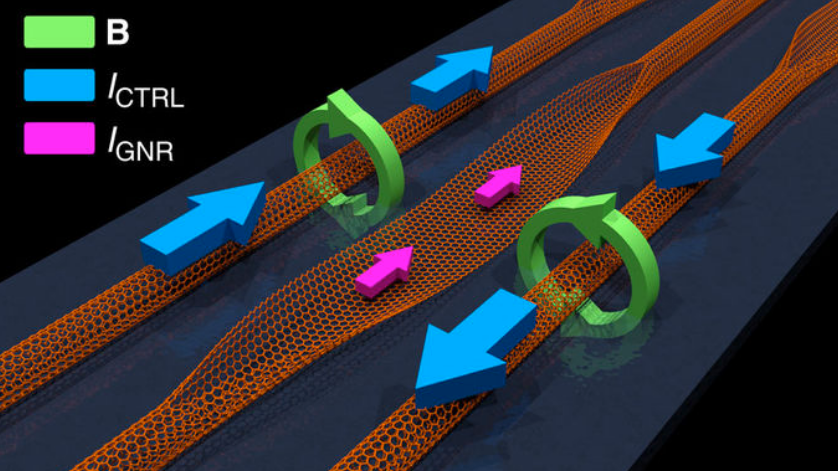Graphene-based computer would be 1,000 times faster than silicon-based, use 100th the power
June 15, 2017

How a graphene-based transistor would work. A graphene nanoribbon (GNR) is created by unzipping (opening up) a portion of a carbon nanotube (CNT) (the flat area, shown with pink arrows above it). The GRN switching is controlled by two surrounding parallel CNTs. The magnitudes and relative directions of the control current, ICTRL (blue arrows) in the CNTs determine the rotation direction of the magnetic fields, B (green). The magnetic fields then control the GNR magnetization (based on the recent discovery of negative magnetoresistance), which causes the GNR to switch from resistive (no current) to conductive, resulting in current flow, IGNR (pink arrows) — in other words, causing the GNR to act as a transistor gate. The magnitude of the current flow through the GNR functions as the binary gate output — with binary 1 representing the current flow of the conductive state and binary 0 representing no current (the resistive state). (credit: Joseph S. Friedman et al./Nature Communications)
A future graphene-based transistor using spintronics could lead to tinier computers that are a thousand times faster and use a hundredth of the power of silicon-based computers.
The radical transistor concept, created by a team of researchers at Northwestern University, The University of Texas at Dallas, University of Illinois at Urbana-Champaign, and University of Central Florida, is explained this month in an open-access paper in the journal Nature Communications.
Transistors act as on and off switches. A series of transistors in different arrangements act as logic gates, allowing microprocessors to solve complex arithmetic and logic problems. But the speed of computer microprocessors that rely on silicon transistors has been relatively stagnant since around 2005, with clock speeds mostly in the 3 to 4 gigahertz range.
Clock speeds approaching the terahertz range
The researchers discovered that by applying a magnetic field to a graphene ribbon (created by unzipping a carbon nanotube), they could change the resistance of current flowing through the ribbon. The magnetic field — controlled by increasing or decreasing the current through adjacent carbon nanotubes — increased or decreased the flow of current.
A cascading series of graphene transistor-based logic circuits could produce a massive jump, with clock speeds approaching the terahertz range — a thousand times faster.* They would also be smaller and substantially more efficient, allowing device-makers to shrink technology and squeeze in more functionality, according to Ryan M. Gelfand, an assistant professor in The College of Optics & Photonics at the University of Central Florida.
The researchers hope to inspire the fabrication of these cascaded logic circuits to stimulate a future transformative generation of energy-efficient computing.
* Unlike other spintronic logic proposals, these new logic gates can be cascaded directly through the carbon materials without requiring intermediate circuits and amplification between gates. That would result in compact circuits with reduced area that are far more efficient than with CMOS switching, which is limited by charge transfer and accumulation from RLC (resistance-inductance-capacitance) interconnect delays.
Abstract of Cascaded spintronic logic with low-dimensional carbon
Remarkable breakthroughs have established the functionality of graphene and carbon nanotube transistors as replacements to silicon in conventional computing structures, and numerous spintronic logic gates have been presented. However, an efficient cascaded logic structure that exploits electron spin has not yet been demonstrated. In this work, we introduce and analyse a cascaded spintronic computing system composed solely of low-dimensional carbon materials. We propose a spintronic switch based on the recent discovery of negative magnetoresistance in graphene nanoribbons, and demonstrate its feasibility through tight-binding calculations of the band structure. Covalently connected carbon nanotubes create magnetic fields through graphene nanoribbons, cascading logic gates through incoherent spintronic switching. The exceptional material properties of carbon materials permit Terahertz operation and two orders of magnitude decrease in power-delay product compared to cutting-edge microprocessors. We hope to inspire the fabrication of these cascaded logic circuits to stimulate a transformative generation of energy-efficient computing.